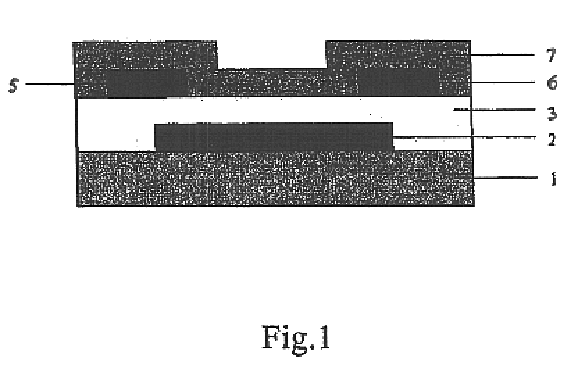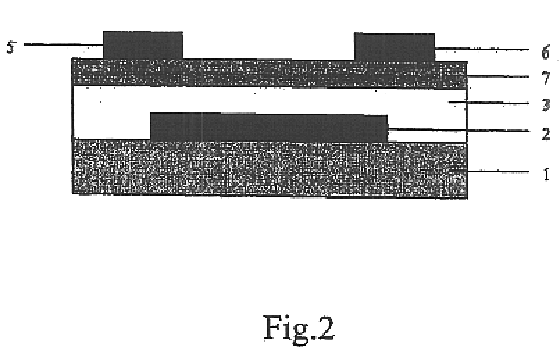Organic thin film transistor (OTFT)
a thin film transistor and organic technology, applied in the direction of thermoelectric devices, bulk negative resistance effect devices, radiation controlled devices, etc., can solve the problems of increasing the leakage current between the gate electrode and the source electrode, comparatively difficult to deal with the fine finish of this kind of device, and poor insulatibity of materials with high dielectric constants, so as to achieve effective reduction of leakage current and high performan
- Summary
- Abstract
- Description
- Claims
- Application Information
AI Technical Summary
Benefits of technology
Problems solved by technology
Method used
Image
Examples
example 1
As shown in FIG. 6, a layer of metal Ta was plated on a 7059 glass substrate (1) by the RF magnetism controlled sputtering method. The sputtering conditions were as follows: a background vacuum of 2×10−3 Pa; a Ar pressure of 1 Pa; a RF power of 500 W; and a substrate temperature of 100 centigrade. Then the layer of metal Ta was shaped into the gate electrode (2) by the photolithography method. A layer of Ta2O5 400 nm in thickness and a layer of SiO2 300 nm in thickness were continuously sputtered on the gate electrode respectively as the gate insulation layer (3) and the second insulation layer (4) by the DC magnetism controlled sputtering method. The reactive sputtering conditions were as follows: a background vacuum of 2×10−3 Pa; a O2 pressure of 0.9 Pa; a DC power of 500 W; and a substrate temperature of 100 centigrade. Next, the photo-resist was coated, exposed and developed. Then a layer of Au 100 nm in thickness was formed by the method of heat evaporation at a vacuum of 10−5 ...
example 2
As shown in FIG. 6, a layer of alloy MoW was plated on the flexible plastic substrate (1) by co-sputtering target Mo and W using the RF magnetism controlled sputtering method. The sputtering conditions are as follows: a background vacuum of 2×10−3 Pa; a Ar pressure of 1 Pa; a RF power of 500 W; and a substrate temperature of 100 centigrade. Then the layer of metal Ta was shaped into the gate electrode (2) by the photolithography method. A layer of Ta2O5 500 nm in thickness was sputtered on the gate electrode as the gate insulation layer (3) by the DC magnetism controlled sputtering method. The reactive sputtering conditions were as follows: a background vacuum of 2×10−3 Pa; a O2 pressure of 0.9 Pa; a DC power of 500 W; and a substrate temperature of 100 centigrade. Subsequently, a layer of poly(methyl methacrylate) (PMMA) 300 nm in thickness was spin coated as the second insulation layer (4). Next, the photo-resist was coated, exposed and developed. Then a layer of silver (Ag) 100 n...
example 3
As shown in FIG. 6, a layer of metal Cr was plated on the flexible plastic substrate (1) by sputtering target Cr using the RF magnetism controlled sputtering method. The sputtering conditions are as follows: a background vacuum of 2×10−3 Pa; a Ar pressure of 1 Pa; a RF power of 500 W; and a substrate temperature of 100 centigrade. Then the layer of metal Ta was shaped into the gate electrode (2) by the photolithography method. A layer of TiO2 500 nm in thickness was sputtered on the gate electrode as the gate insulation layer (3) by the DC magnetism controlled sputtering method. The reactive sputtering conditions were as follows: a background vacuum of 2×10−3 Pa; a O2 pressure of 0.9 Pa; a DC power of 500 W; and a substrate temperature of 100 centigrade. Subsequently, a layer of polyimide 300 nm in thickness was spin coated as the second insulation layer (4). Next, a layer of silver (Al) 100 nm in thickness was formed by the method of heat evaporation at a vacuum of 10−5 Pa. Then, t...
PUM
 Login to View More
Login to View More Abstract
Description
Claims
Application Information
 Login to View More
Login to View More - R&D
- Intellectual Property
- Life Sciences
- Materials
- Tech Scout
- Unparalleled Data Quality
- Higher Quality Content
- 60% Fewer Hallucinations
Browse by: Latest US Patents, China's latest patents, Technical Efficacy Thesaurus, Application Domain, Technology Topic, Popular Technical Reports.
© 2025 PatSnap. All rights reserved.Legal|Privacy policy|Modern Slavery Act Transparency Statement|Sitemap|About US| Contact US: help@patsnap.com



